茶文化翻译
- 格式:doc
- 大小:24.50 KB
- 文档页数:1

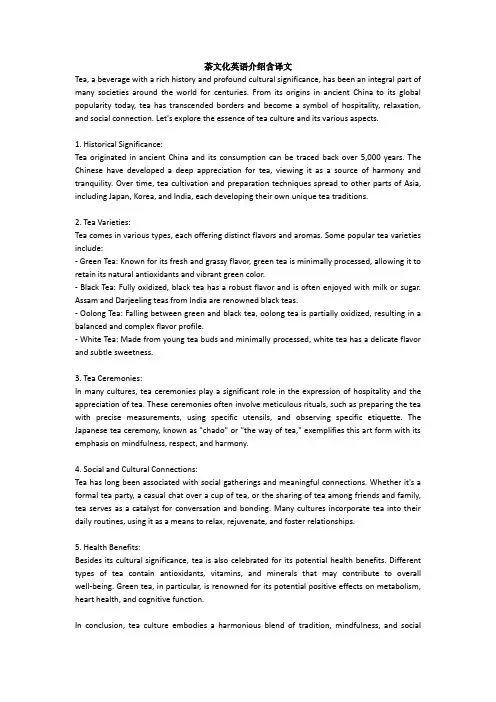
茶文化英语介绍含译文Tea, a beverage with a rich history and profound cultural significance, has been an integral part of many societies around the world for centuries. From its origins in ancient China to its global popularity today, tea has transcended borders and become a symbol of hospitality, relaxation, and social connection. Let's explore the essence of tea culture and its various aspects.1. Historical Significance:Tea originated in ancient China and its consumption can be traced back over 5,000 years. The Chinese have developed a deep appreciation for tea, viewing it as a source of harmony and tranquility. Over time, tea cultivation and preparation techniques spread to other parts of Asia, including Japan, Korea, and India, each developing their own unique tea traditions.2. Tea Varieties:Tea comes in various types, each offering distinct flavors and aromas. Some popular tea varieties include:- Green Tea: Known for its fresh and grassy flavor, green tea is minimally processed, allowing it to retain its natural antioxidants and vibrant green color.- Black Tea: Fully oxidized, black tea has a robust flavor and is often enjoyed with milk or sugar. Assam and Darjeeling teas from India are renowned black teas.- Oolong Tea: Falling between green and black tea, oolong tea is partially oxidized, resulting in a balanced and complex flavor profile.- White Tea: Made from young tea buds and minimally processed, white tea has a delicate flavor and subtle sweetness.3. Tea Ceremonies:In many cultures, tea ceremonies play a significant role in the expression of hospitality and the appreciation of tea. These ceremonies often involve meticulous rituals, such as preparing the tea with precise measurements, using specific utensils, and observing specific etiquette. The Japanese tea ceremony, known as "chado" or "the way of tea," exemplifies this art form with its emphasis on mindfulness, respect, and harmony.4. Social and Cultural Connections:Tea has long been associated with social gatherings and meaningful connections. Whether it's a formal tea party, a casual chat over a cup of tea, or the sharing of tea among friends and family, tea serves as a catalyst for conversation and bonding. Many cultures incorporate tea into their daily routines, using it as a means to relax, rejuvenate, and foster relationships.5. Health Benefits:Besides its cultural significance, tea is also celebrated for its potential health benefits. Different types of tea contain antioxidants, vitamins, and minerals that may contribute to overall well-being. Green tea, in particular, is renowned for its potential positive effects on metabolism, heart health, and cognitive function.In conclusion, tea culture embodies a harmonious blend of tradition, mindfulness, and socialconnection. With its diverse varieties, meaningful ceremonies, and health benefits, tea continues to be cherished and enjoyed by people from various cultures worldwide. Whether you're sipping a soothing cup of green tea or participating in an elaborate tea ceremony, tea invites us to appreciate the simple joys of life and embrace moments of tranquility.译文:茶是一种具有悠久历史和深厚文化意义的饮料,几个世纪以来一直是世界各地许多社会不可或缺的一部分。
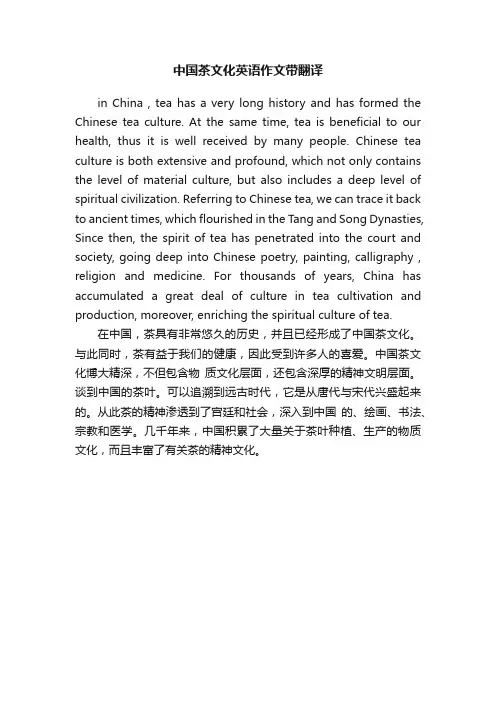
中国茶文化英语作文带翻译in China , tea has a very long history and has formed the Chinese tea culture. At the same time, tea is beneficial to our health, thus it is well received by many people. Chinese tea culture is both extensive and profound, which not only contains the level of material culture, but also includes a deep level of spiritual civilization. Referring to Chinese tea, we can trace it back to ancient times, which flourished in the Tang and Song Dynasties, Since then, the spirit of tea has penetrated into the court and society, going deep into Chinese poetry, painting, calligraphy , religion and medicine. For thousands of years, China has accumulated a great deal of culture in tea cultivation and production, moreover, enriching the spiritual culture of tea.在中国,茶具有非常悠久的历史,并且已经形成了中国茶文化。
与此同时,茶有益于我们的健康,因此受到许多人的喜爱。
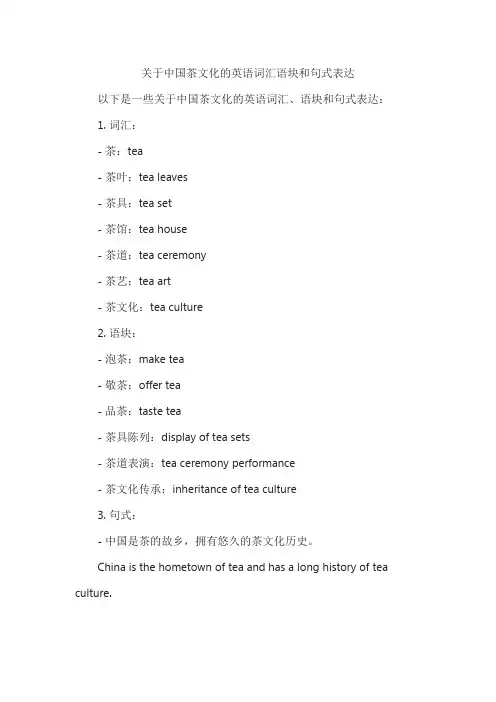
关于中国茶文化的英语词汇语块和句式表达以下是一些关于中国茶文化的英语词汇、语块和句式表达:1. 词汇:- 茶:tea- 茶叶:tea leaves- 茶具:tea set- 茶馆:tea house- 茶道:tea ceremony- 茶艺:tea art- 茶文化:tea culture2. 语块:- 泡茶:make tea- 敬茶:offer tea- 品茶:taste tea- 茶具陈列:display of tea sets- 茶道表演:tea ceremony performance- 茶文化传承:inheritance of tea culture3. 句式:- 中国是茶的故乡,拥有悠久的茶文化历史。
China is the hometown of tea and has a long history of tea culture.- 茶道是一种通过泡茶、敬茶和品茶等环节来表达敬意和感恩的艺术形式。
Tea ceremony is an art form that expresses respect and gratitude through the procedures of making, offering and tasting tea.- 茶文化是中国传统文化的重要组成部分,它体现了中国人对生活品质和精神追求的追求。
Tea culture is an important part of Chinese traditional culture, embodying the Chinese people's pursuit of life quality and spiritual pursuit.- 中国的茶馆是人们休闲、社交和品尝茶文化的好去处。
Chinese tea houses are good places for people to relax, socialize and experience tea culture.- 学习茶道可以帮助人们提高修养、培养内心平静和增进人际关系。
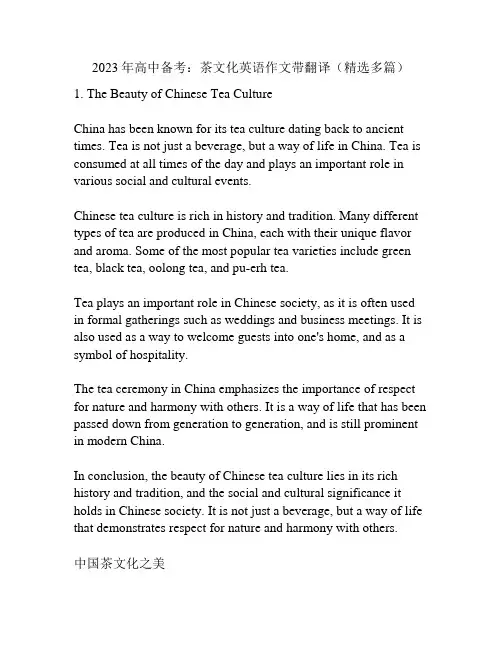
2023年高中备考:茶文化英语作文带翻译(精选多篇)1. The Beauty of Chinese Tea CultureChina has been known for its tea culture dating back to ancient times. Tea is not just a beverage, but a way of life in China. Tea is consumed at all times of the day and plays an important role in various social and cultural events.Chinese tea culture is rich in history and tradition. Many different types of tea are produced in China, each with their unique flavor and aroma. Some of the most popular tea varieties include green tea, black tea, oolong tea, and pu-erh tea.Tea plays an important role in Chinese society, as it is often used in formal gatherings such as weddings and business meetings. It is also used as a way to welcome guests into one's home, and as a symbol of hospitality.The tea ceremony in China emphasizes the importance of respect for nature and harmony with others. It is a way of life that has been passed down from generation to generation, and is still prominent in modern China.In conclusion, the beauty of Chinese tea culture lies in its rich history and tradition, and the social and cultural significance it holds in Chinese society. It is not just a beverage, but a way of life that demonstrates respect for nature and harmony with others.中国茶文化之美中国自古就以茶文化而著名。
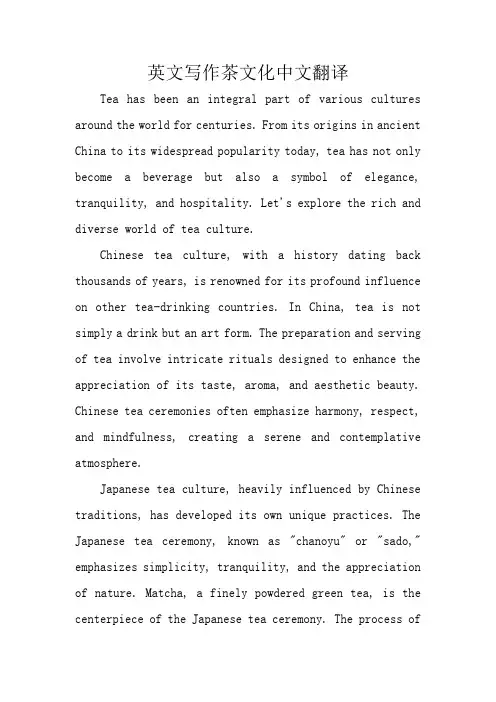
英文写作茶文化中文翻译Tea has been an integral part of various cultures around the world for centuries. From its origins in ancient China to its widespread popularity today, tea has not only become a beverage but also a symbol of elegance, tranquility, and hospitality. Let's explore the rich and diverse world of tea culture.Chinese tea culture, with a history dating back thousands of years, is renowned for its profound influence on other tea-drinking countries. In China, tea is not simply a drink but an art form. The preparation and serving of tea involve intricate rituals designed to enhance the appreciation of its taste, aroma, and aesthetic beauty. Chinese tea ceremonies often emphasize harmony, respect, and mindfulness, creating a serene and contemplative atmosphere.Japanese tea culture, heavily influenced by Chinese traditions, has developed its own unique practices. The Japanese tea ceremony, known as "chanoyu" or "sado," emphasizes simplicity, tranquility, and the appreciation of nature. Matcha, a finely powdered green tea, is the centerpiece of the Japanese tea ceremony. The process ofpreparing and serving matcha involves precise movements and gestures, showcasing the beauty of minimalism and attention to detail.In India, tea holds a significant cultural and social importance. Masala chai, a spiced tea blend, is a popular choice in Indian households. Tea is not only enjoyed as a refreshing beverage but also serves as a catalyst for social gatherings and discussions. The concept of "chai pe charcha," meaning "tea and conversation," reflects the role of tea as a facilitator of connections and conversations among people.Tea culture is not limited to East Asia and India. In the United Kingdom, the tradition of afternoon tea holds a special place. It is a cherished ritual that typically involves tea served with scones, finger sandwiches, and pastries. The British take pride in their tea etiquette, with proper teapot pouring techniques and the use of fine china.No matter where tea culture is embraced, it promotes a sense of relaxation, mindfulness, and social interaction. Whether it is a formal ceremony or a casual gathering with friends, tea offers a moment of pause in our busy lives,allowing us to appreciate the simple pleasures and connect with others.中文翻译为:茶在世界各地的文化中已经有数百年的历史,它不仅成为一种饮料,更是优雅、宁静和热情待客的象征。
![[传统文化]中国茶文化英语介绍](https://uimg.taocdn.com/bd87729d185f312b3169a45177232f60ddcce7b6.webp)
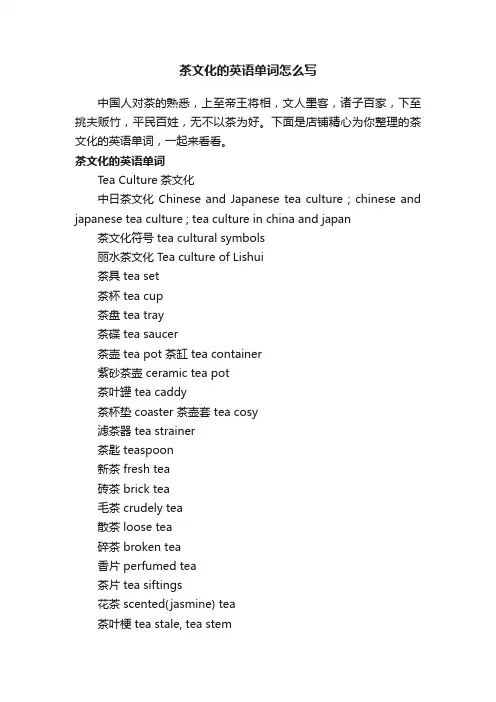
茶文化的英语单词怎么写中国人对茶的熟悉,上至帝王将相,文人墨客,诸子百家,下至挑夫贩竹,平民百姓,无不以茶为好。
下面是店铺精心为你整理的茶文化的英语单词,一起来看看。
茶文化的英语单词Tea Culture茶文化中日茶文化Chinese and Japanese tea culture ; chinese and japanese tea culture ; tea culture in china and japan茶文化符号 tea cultural symbols丽水茶文化 Tea culture of Lishui茶具 tea set茶杯 tea cup茶盘 tea tray茶碟 tea saucer茶壶 tea pot 茶缸 tea container紫砂茶壶 ceramic tea pot茶叶罐 tea caddy茶杯垫 coaster 茶壶套 tea cosy滤茶器 tea strainer茶匙 teaspoon新茶 fresh tea砖茶 brick tea毛茶 crudely tea散茶 loose tea碎茶 broken tea香片 perfumed tea茶片 tea siftings花茶 scented(jasmine) tea茶叶梗 tea stale, tea stem沏新茶 making fresh tea上茶offering tea, tea serving淡茶weak tea浓茶 strong tea抿茶 sipping tea茶园 tea garden茶馆tea house茶几 tea table茶篮 tea basket滤茶球 tea ball减肥茶 diet(slimming)tea保健茶 tonic tea凉茶精 herb ingredients美容茶 cosmetic tea人参茶ginseng tea姜茶 ginger tea速溶茶instant tea茶叶蛋 salty eggs cooked in tea擂茶 mashed tea盖碗茶 tea served in a set of cups茶叶表演 tea-serving performance茶叶种类介绍1. 绿茶:茶是不经过发酵的茶,即将鲜叶经过摊晾后直接下到一二百度的热锅里炒制,以保持其绿色的特点。
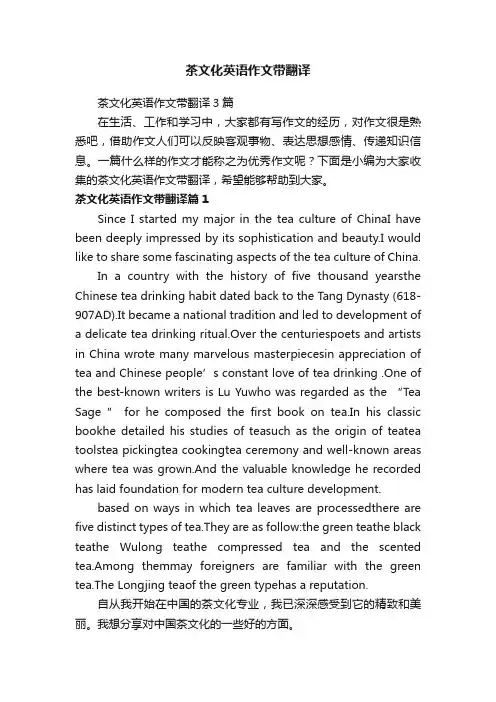
茶文化英语作文带翻译茶文化英语作文带翻译3篇在生活、工作和学习中,大家都有写作文的经历,对作文很是熟悉吧,借助作文人们可以反映客观事物、表达思想感情、传递知识信息。
一篇什么样的作文才能称之为优秀作文呢?下面是小编为大家收集的茶文化英语作文带翻译,希望能够帮助到大家。
茶文化英语作文带翻译篇1Since I started my major in the tea culture of ChinaI have been deeply impressed by its sophistication and beauty.I would like to share some fascinating aspects of the tea culture of China.In a country with the history of five thousand yearsthe Chinese tea drinking habit dated back to the Tang Dynasty (618-907AD).It became a national tradition and led to development of a delicate tea drinking ritual.Over the centuriespoets and artists in China wrote many marvelous masterpiecesin appreciation of tea and Chinese people’s constant love of tea drinking .One of the best-known writers is Lu Yuwho was regarded as the “Tea Sage ” for he composed the first book on tea.In his classic bookhe detailed his studies of teasuch as the origin of teatea toolstea pickingtea cookingtea ceremony and well-known areas where tea was grown.And the valuable knowledge he recorded has laid foundation for modern tea culture development.based on ways in which tea leaves are processedthere are five distinct types of tea.They are as follow:the green teathe black teathe Wulong teathe compressed tea and the scented tea.Among themmay foreigners are familiar with the green tea.The Longjing teaof the green typehas a reputation.自从我开始在中国的茶文化专业,我已深深感受到它的精致和美丽。
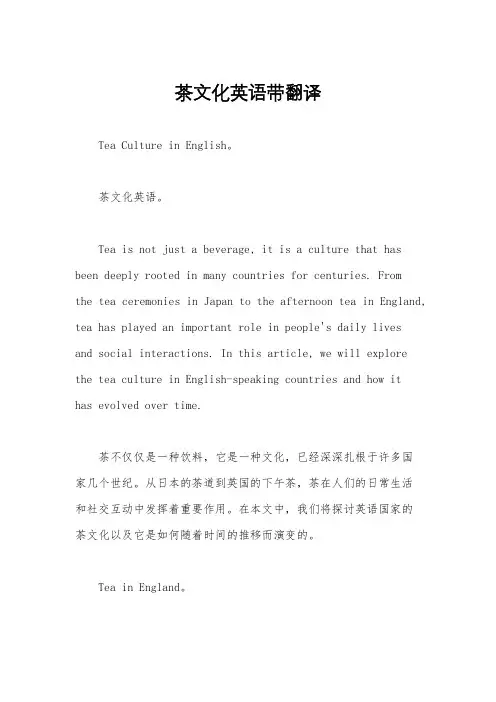
茶文化英语带翻译Tea Culture in English。
茶文化英语。
Tea is not just a beverage, it is a culture that has been deeply rooted in many countries for centuries. Fromthe tea ceremonies in Japan to the afternoon tea in England, tea has played an important role in people's daily livesand social interactions. In this article, we will explore the tea culture in English-speaking countries and how ithas evolved over time.茶不仅仅是一种饮料,它是一种文化,已经深深扎根于许多国家几个世纪。
从日本的茶道到英国的下午茶,茶在人们的日常生活和社交互动中发挥着重要作用。
在本文中,我们将探讨英语国家的茶文化以及它是如何随着时间的推移而演变的。
Tea in England。
英国的茶文化。
Tea has been a popular beverage in England since the17th century, when it was introduced by Catherine of Braganza, the queen consort of King Charles II. However, it was not until the 19th century that tea became a staple of British culture, thanks to the development of tea plantations in India and the reduction of its price. This led to the creation of the tradition of afternoon tea, which is still popular today.自17世纪以来,茶在英国一直是一种受欢迎的饮料,当时由查尔斯二世国王的皇后卡瑟琳·布拉干萨引入。
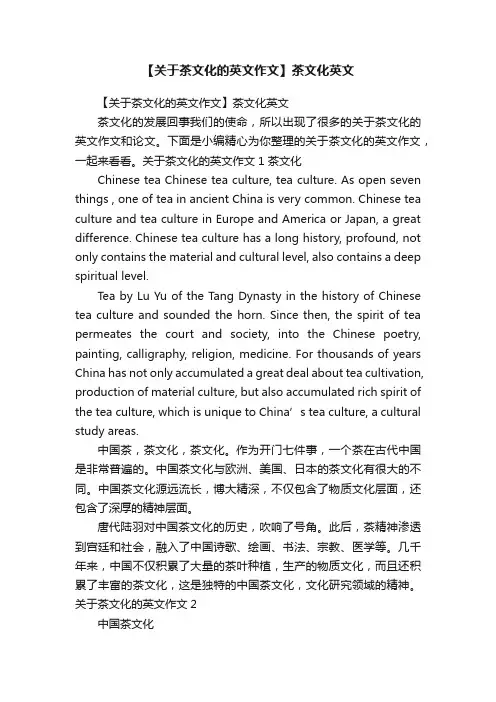
【关于茶文化的英文作文】茶文化英文【关于茶文化的英文作文】茶文化英文茶文化的发展回事我们的使命,所以出现了很多的关于茶文化的英文作文和论文。
下面是小编精心为你整理的关于茶文化的英文作文,一起来看看。
关于茶文化的英文作文1 茶文化Chinese tea Chinese tea culture, tea culture. As open seven things , one of tea in ancient China is very common. Chinese tea culture and tea culture in Europe and America or Japan, a great difference. Chinese tea culture has a long history, profound, not only contains the material and cultural level, also contains a deep spiritual level.Tea by Lu Yu of the Tang Dynasty in the history of Chinese tea culture and sounded the horn. Since then, the spirit of tea permeates the court and society, into the Chinese poetry, painting, calligraphy, religion, medicine. For thousands of years China has not only accumulated a great deal about tea cultivation, production of material culture, but also accumulated rich spirit of the tea culture, which is unique to China’s tea culture, a cultural study areas.中国茶,茶文化,茶文化。
茶文化的英语单词怎么写TeaCulture茶文化中日茶文化ChineseandJapaneseteaculture;chineseandjapaneseteaculture;t eacultureinchinaandjapan茶文化符号teaculturalsymbols丽水茶文化TeacultureofLishui茶具teaset茶杯teacup茶盘teatray茶碟teasaucer茶壶teapot茶缸teacontainer紫砂茶壶ceramicteapot茶叶罐teacaddy茶杯垫coaster茶壶套teacosy滤茶器teastrainer茶匙teaspoon新茶freshtea砖茶bricktea毛茶crudelytea散茶loosetea碎茶brokentea香片perfumedtea茶片teasiftings花茶scented(jasmine)tea茶叶梗teastale,teastem沏新茶makingfreshtea上茶offeringtea,teaserving 淡茶weaktea浓茶strongtea抿茶sippingtea茶园teagarden茶馆teahouse茶几teatable茶篮teabasket滤茶球teaball减肥茶diet(slimming)tea保健茶tonictea凉茶精herbingredients美容茶cosmetictea人参茶ginsengtea姜茶gingertea速溶茶instanttea茶叶蛋saltyeggscookedintea 擂茶mashedtea盖碗茶teaservedinasetofcups茶叶表演tea-servingperformance1.绿茶:茶是不经过发酵的茶,即将鲜叶经过摊晾后直接下到一二百度的热锅里炒制,以保持其绿色的特点。
主要花色有:西湖龙井茶、日照绿茶、雪青茶、碧罗春茶、黄山毛峰茶、庐山云雾、六安瓜片、蒙顶茶、太平猴魁茶、顾渚紫笋茶、信阳毛尖茶、竹叶青、都匀毛尖、平水珠茶、西山茶、雁荡毛峰茶、华顶云雾茶、涌溪火青茶、敬亭绿雪茶、峨眉峨蕊茶、都匀毛尖茶、恩施玉露茶、婺源茗眉茶、雨花茶、莫干黄芽茶、五山盖米茶、普陀佛茶、西农毛尖。
茶文化英语句子与翻译中国是茶的故乡,茶文化的发祥地。
China is the hometomn of tea and cradle of tea culture.丰富了茶文化的内涵。
And help tourists understand the local tea culture.这里常常举行茶道表演,以使茶文化更加深入人心。
Tea ceremonies are often held here so as to make tea culture better known among common people.本店也将不定期的举办名茶鑑赏会与茶文化的基本知识讲座。
We will also host occasional tea appreciation with the basic knowledge of tea culture lectures.8世纪中叶出现了第一个茶文化的先驱,是陆羽。
With Luwuh in the middle of the eighth century we have our first apostle of tea.是世界上第一部有关于茶文化的著作。
Was the world's first literature on tea culture.因此,茶文化园的这些特色,必能吸引很多游客观光、休闲。
And an overpass and a Service Center will be set up here along the superhighway.中国茶文化的发展及在和谐社会建设中的作用China's Tea Cultural Development and Its Role in Harmonious Society Construction如果你对茶文化感兴趣,你可以去中国学习。
If you are interested in tea culture you can study it in China.这里可是中国茶文化之乡啊。
茶文化和茶道的英文翻译中国茶文化是中国制茶、饮茶的文化。
下面是店铺精心为你整理的茶文化和茶道的英文翻译,一起来看看。
茶文化和茶道的英文翻译茶文化tea culture茶道teaism; tea ceremony ;中国茶文化Chinese Tea Culture英国茶文化British Tea Culture茶文化的功能茶文化的社会功能主要表现在发扬茶德、传播茶道、文化艺术、修身养性、陶冶情操、促进民族团结、表现社会进步和发展经济贸易等。
茶德是经过几千年积淀下来的被历代人们所推崇的茶内在具备的美好品性。
茶文化具有的传统主要有热爱祖国、无私奉献、坚韧不拔、谦虚礼貌、勤奋节俭和相敬互让等。
吴觉农先生和湖南刘先和,为茶叶事业鞠躬尽瘁,既是爱国主义者,又是当代茶人杰出代表。
陆羽《茶经》,是古代茶人勤奋读书、刻苦学习、潜心求索、百折不挠精神的结晶。
以茶待客、以茶代酒,“清茶一杯也醉人”就是汉民族珍惜劳动成果、勤奋节俭的真实反映。
以茶字当头排列茶文化的社会功能有“以茶思源、以茶待客、以茶会友、以茶联谊、以茶廉政、以茶育人、以茶代酒、以茶健身、以茶入诗、以茶入艺、以茶入画、以茶起舞、以茶歌呤、以茶兴文、以茶作礼、以茶兴农、以茶促贸和以茶致富。
茶是中国的骄傲、民族的自尊、自信和自豪。
饮茶可以思源。
世界著名科技史家李约瑟博士,将中国茶叶作为中国四大发明(火药、造纸、指南针和印刷术)之后,对人类的第五个重大贡献。
唐代陆羽《茶经》是世界第一部茶书。
中国茶文化对世界影响功能显著。
以茶会友是茶文化最广泛的社会功能之一。
今天所处的市场经济,竞争激烈,优胜劣汰,讲利益、讲效益。
但人情较为冷漠,人际关系趋于淡漠。
通过茶楼、茶艺馆品茗或茶艺,朋友聚在一起,互通信息,交流感情,增进了解,沟通友谊。
朋友相聚在旧式茶馆里,随意说笑,回忆人生,重新享受到生命的乐趣。
古代就有“寒夜客来茶当酒”之说,以茶代酒体现传统美德,符合今天中央倡导的厉行节约制止奢侈浪费行为的规定要求。
茶文化的英语作文_tea culture 5篇导读:关于”茶文化“的英语作文模板5篇,作文题目:tea culture。
以下是关于茶文化的八年级英语模板,每篇作文均为真题模板带翻译。
关于”茶文化“的英语作文模板5篇,作文题目:tea culture。
以下是关于茶文化的xx年级英语模板,每篇作文均为真题模板带翻译。
高分英语作文1:tea cultureChinese tea has a long history. A series of unique tea cultures, from tea cultivation, preservation, picking to processing and sampling, are mainly produced in Jiangnan to Yangtze River Basin. The climate is mild and the soil is fertile.For example, Zhejiang, Yunnan, Guizhou, Fujian and other provinces are rich in famous tea varieties such as Longjin, Wulong and Pu'er. Tieguangyin tea culture is the common characteristics of all ethnic groups in China People believe that it is not perfect not to drink tea for a day, whether in the warm southern mountains or on the frozen northern grasslands. Kungfu tea, butter tea and milk tea are all the favorite drinks for people.Both ancient and modern Chinese tend to teach poetry, prose, dance and dramahttp://wwwseechinacomcn/zhlc/zhlccontenthp3fdattend=3&isEn glish=0&fdZHLCId=.中文翻译:中国茶叶有着多年的历史,从茶树栽培、保存、采摘到加工、取样等一系列独具特色的茶文化主要产于江南至长江流域,气候温和,土壤肥沃,如浙江、云南、贵州、福建等省,盛产龙津、武隆、普洱等名茶品种,铁广银茶文化是中国各民族的共同特点,许多中国人认为,无论是在温暖的南方山区,还是在冰冻的北方草原上,一天不喝茶都是不完美的,功夫茶、酥油茶、奶茶等都是人们最爱喝的饮料,无论是古代还是现代的中国人,都倾向于对诗歌、散文、舞蹈和戏剧的阐述教学http://wwwseechinacomcn/zhlc/zhlccontenthp3fdattend=3&isEngli sh=0&fdZHLCId=。
Tea culture茶文化China is the home of tea, and tea culture has a long history.中国是茶的故乡,茶文化也源远流长。
Tea is a drink that can excite people and is also one of the symbols of Chinese culture.茶是一种可以帮人提神的饮品,也是中华文化的象征之一。
In China, tea is not only a drink, but also a display of lifestyle and cultural spirit.在中国,茶不仅是一种饮品,更是一种生活方式和文化精神的体现。
China has a wide variety of tea, including green tea, black tea, oolong tea, white tea, yellow tea, etc.中国的茶叶品种繁多,其中包括绿茶、红茶、乌龙茶、白茶、黄茶等。
Each kind of tea has its own unique characteristics and taste, and different varieties are suitable for different people and occasions.每种茶叶都有其独特的特点和口感,品种不同适合的人群和场合也不同。
When drinking tea, Chinese people pay attention to the quality, color, taste and other aspects of the tea.喝茶时,中国人注重茶的品质、色泽、口感等方面。
The process of tea tasting is also a cultural activity, which requires a special tea set.品茶的过程也是一种文化活动,需要有专门的茶具。
中国是一个文化历史悠久的(time-honored)国度,也是一个礼仪(ceremony and decorum)之邦。
每当客人来访,都需要泡茶给客人喝。
在给客人奉茶之前,你应该问问他们都喜欢喝什么类型的茶,并采用最合适的茶具奉上。
奉茶期间,主人需要仔细留意客人的茶杯里的茶量。
通常,若是用茶杯泡的茶,在茶喝完一半之后就应该加开水,这样,茶杯就一直都是满的,茶的芳香(bouquet)也得以保留。
参考译文
China is a country with a time-honored civilization and also a land of ceremony and decorum. Whenever guests visit, it is necessary to make and serve tea to them. Before serving tea, you may ask them for their preferences as to what kind of tea they fancy, and serve them the tea in the most appropriate teacups. In the course of serving tea, the host should take careful note of how much water remains in the guests’cups. Usually, if the tea is made in a teacup, boiling water should be added into the cup when half of the tea in it has been consumed; and thus the cup is kept filled and the tea retains the same bouquet.。